
The Sinclair ZX80 is a home computer launched on 29 January 1980 by Science of Cambridge Ltd.. It is notable for being one of the first computers available in the United Kingdom for less than a hundred pounds. It was available in kit form for £79.95, where purchasers had to assemble and solder it together, and as a ready-built version at £99.95. The ZX80 was very popular straight away, and for some time there was a waiting list of several months for either version of the machine.

The ZX Spectrum is an 8-bit personal home computer developed by Sinclair Research. It was first released in the United Kingdom on 23 April 1982 and went on to become Britain's best-selling microcomputer.
Currah was a British computer peripheral manufacturer, famous mainly for the speech synthesis ROM cartridges it designed for the ZX Spectrum, Commodore 64, and other 8-bit home computers of the 1980s.
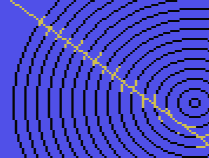
Attribute clash is a display artifact caused by limits in the graphics circuitry of some colour 8-bit home computers, most notably the Sinclair ZX Spectrum, where it meant that only two colours could be used in any 8×8 tile of pixels. The effect was also noticeable on MSX software and in some Commodore 64 titles. Workarounds to prevent this limit from becoming apparent have since been considered an element of Spectrum programmer culture.

Bug-Byte Software Ltd. was a video game company founded in 1980 by Tony Baden and Tony Milner, two Oxford chemistry graduates. It was one of the first to develop a range of 8-bit computer games during the early 1980s, for Sinclair, Commodore and other home computer brands, particularly for the Spectrum. Among the better known titles are Manic Miner and Twin Kingdom Valley.
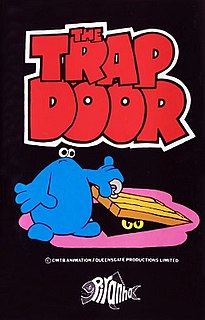
The Trap Door is a video game published for the ZX Spectrum in 1986 by Piranha Software and ported to the Amstrad CPC and Commodore 64 by Five Ways Software. It was written by Don Priestley and based on the British children's television show of the same name.
Quicksilva was a British games software publisher active during the early 1980s.
Crystal Computing, later renamed Design Design, was a British video game developer founded in 1982 by Chris Clarke and Ian Stamp while students at the University of Manchester. Graham Stafford, Neil Mottershead, Simon Brattel and Martin Horsley, joined the company as it expanded. The company's first software release was a compilation of games for the Sinclair ZX81, though it was with the ZX Spectrum that Crystal found its greatest success. A deal with the machine's manufacturer Sinclair to distribute Crystal's Zeus Assembler gave the company sufficient funds for a major marketing campaign for their next product, Halls of the Things, an arcade adventure game that became their most successful title.
The ZX Spectrum's software library was very diverse. While the majority of the software produced for the system was video games, others included programming language implementations, Sinclair BASIC extensions, databases, word processors, spread sheets, drawing and painting tools, and 3D modelling tools.
DK'Tronics Ltd was a British software and hardware company active during the 1980s. It primarily made peripherals for the ZX Spectrum and Amstrad CPC but also released video games for the ZX81, ZX Spectrum, Commodore 64, Commodore VIC-20, BBC Micro, Memotech MTX, MSX and Amstrad platforms.
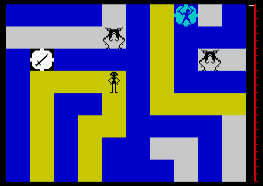
Maziacs is an action adventure maze game published by DK'Tronics in 1983 for the ZX Spectrum, Commodore 64, and MSX.

3D Tanx is a shoot 'em up video game written by Don Priestley and published by DK'Tronics in 1982 for the ZX Spectrum, Commodore 64, and BBC Micro.

Bruce Lee is a platform game written by Ron J. Fortier for the Atari 8-bit family and published in 1984 by Datasoft. The graphics are by Kelly Day and music by John A. Fitzpatrick. The player takes the role of Bruce Lee, while a second player controls either Yamo or alternates with player one for control of Bruce Lee.

Escape is maze video game for the ZX Spectrum developed by New Generation Software and published in 1982.
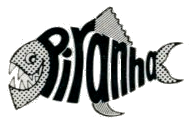
Piranha Software was a short-lived video game publishing label created by Macmillan Publishers in 1986 and closed eighteen months later. In that time it gained a reputation for its unusual output from well known developers such as Don Priestley, Design Design and Delta 4. The majority of their games featured licensed properties including the first video game based on the Discworld novels and two games based on the animated television series The Trap Door.
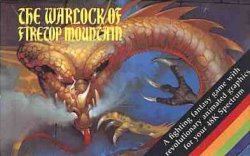
The Warlock of Firetop Mountain is an arcade adventure video game released by Crystal Computing in 1984 for the Sinclair ZX Spectrum home computer. It is loosely based on the adventure gamebook of the same name written by Steve Jackson and Ian Livingstone, and published by Puffin Books in 1982.

Moonlight Madness is a video game for the ZX Spectrum home computer, published in 1986 by Bubble Bus Software. It is an arcade adventure game in which players control a boy scout. The object of the game is to unlock a safe within a mansion to obtain pills for the mansion's owner, a mad scientist, who has collapsed. This requires the player to traverse the mansion's rooms while avoiding hazards such as dangerous house servants and fatal falls.
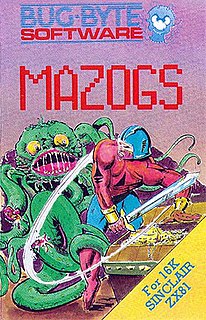
Mazogs is a maze video game and developed by Softsync and published in 1982 for the Timex Sinclair 1000. Another version was programmed by Don Priestley and published for the ZX81 by Bug-Byte.

Magic Bytes is an international video game publishing label. It originated in Germany as the primary computer game brand of micro-partner Software GmbH, already active since 1986 and dedicated to the internal development of some of the games. Initially, Bertelsmann subsidiary Ariolasoft and Gremlin Graphics in the United Kingdom distributed most Magic Bytes games.













